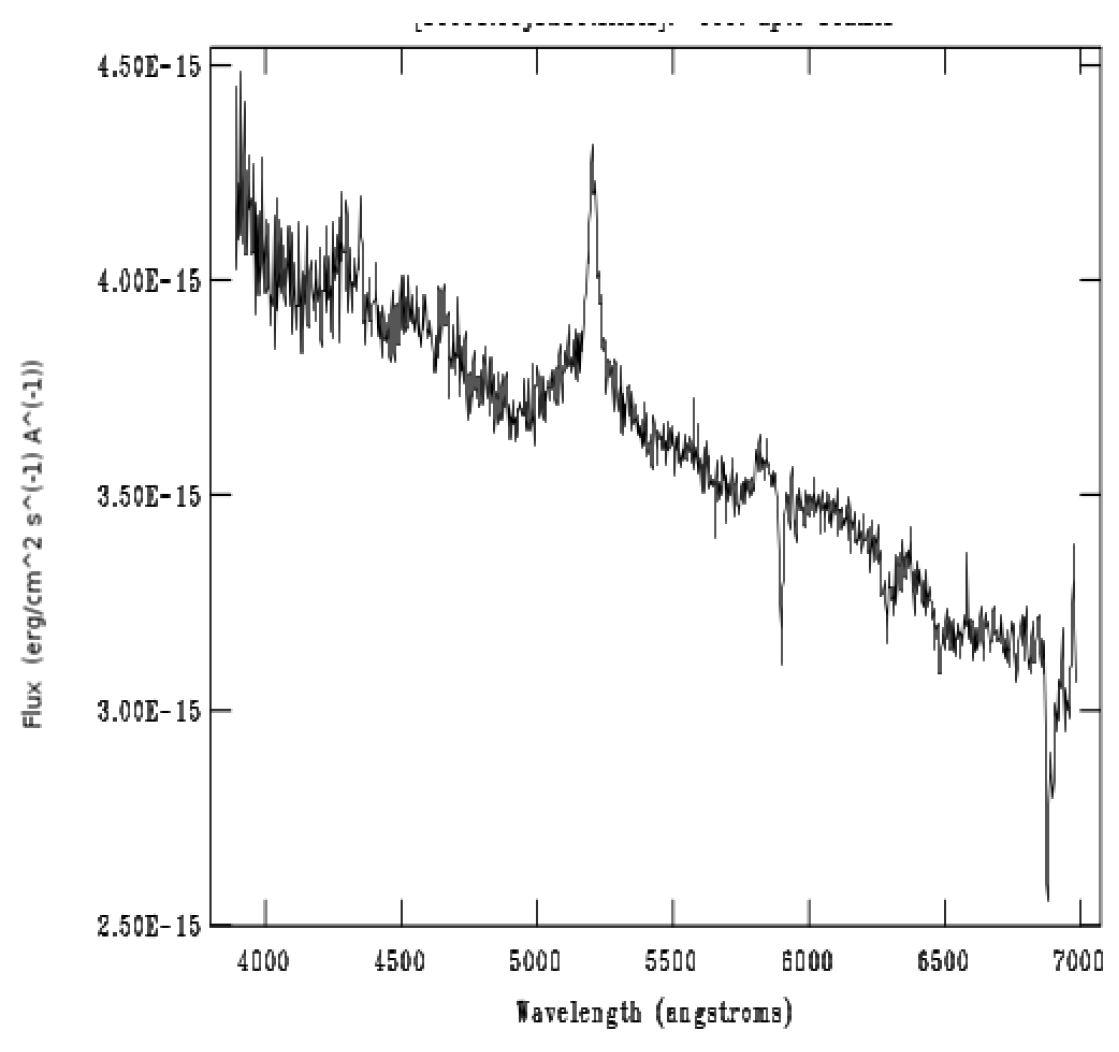Multifrequency Study of the Blazar 3C 454.3
Abstract
:1. Introduction
2. Methods
2.1. Observations
2.2. Data Reduction and Analysis
2.2.1. Spectroscopic Data
2.2.2. Photometry Data
3. Results
3.1. Corrections toward Spectra
Continuum Process
3.2. Photometry Results
3.3. Correlations of Light Curves: IR vs. Gamma and Optical vs. IR
4. Discussion
5. Conclusions
Acknowledgments
Author Contributions
Conflicts of Interest
References
- Vercellone, S.; D’Ammando, F.; Vittorini, V.; Donnarumma, I.; Pucella, G.; Tavani, M.; Ferrari, A.; Raiteri, C.M.; Villata, M.; Romano, P.; et al. Multiwavelength Observations of 3C 454.3: Eighteen Months of Agile Monitoring of the ‘Crazy Diamond’. Astrophys. J. 2010, 712, 405. [Google Scholar] [CrossRef]
- Gu, M.; Cao, X.; Jiang, D.R. On the masses of black holes in radio-loud quasars. Mon. Not. R. Astron. Soc. 2001, 327, 1111–1115. [Google Scholar] [CrossRef]
- Khangulyan, D.V.; Barkov, M.V.; Bosch-Romon, V.; Aharonian, F.A.; Dorodnitsyn, A.V. Star-Jet Interactions and Gamma-Ray Outbursts from 3C454.3. Astrophys. J. 2013, 774, 113. [Google Scholar] [CrossRef]
- Recillas, E.; Carrasco, L.; Escobedo, G.A. NIR Studies of HGalaxies with CANICA. RMxAC 2005, 24, 45–47. Available online: http://citeweb.info/20051140208 (accessed on 15 December 2016). [Google Scholar]
- Bruce, L.G. CCD Transformation equations for use with single image (Differential) photometry. Available online: http://reductionism.net.seanic.net/CCD_TE/cte_alternative.html (accessed on 5 May 2010).
- Finding Charts for AGN. Available online: http://www.lsw.uni-heidelberg.de/projects/extragalactic/charts/ (accessed on 23 September 2009).
- Bonning, E.W.; Bailyn, C.; Urry, C.M.; Buxton, M.; Fossati, G.; Maraschi, L.; Coppi, P.; Scalzo, R.; Isler, J.; Kaptur, A. Correlated variability in the blazar 3C 454.3. Astrophys. J. 2010, 697, L81. [Google Scholar] [CrossRef]
- Raiteri, C.M.; Villata, M.; Chen, W.P.; Hsiao, W.-S.; Kurtanidze, O.M.; Nilsson, K.; Larionov, V.M.; Gurwell, M.A.; Agudo, I.; Aller, H.D.; et al. The high activity of 3C 454.3 in autumn 2007: Monitoring by the WEBT during the AGILE detection. Astron. Astrophys. 2008, 485, L17. [Google Scholar] [CrossRef]
- Villicaña-Pedraza, I. Specific results for 3C 454.3. Multifrequency Study of Extragalactic Sources of Gamma Rays. Thesis 2010. Available online: https://www.researchgate.net/publication/305228473_Multifrequency_study_of_extragalactic_sources_of_gamma_rays (accessed on 13 July 2016).
- Poggianti, B.M. K and evolutionary corrections from UV to IR. Astron. Astrophys. 1997, 122, 399. [Google Scholar] [CrossRef]
- Dunlop, J.S. Quasar Hosts and the Black Hole-Spheroid Connection. arXiv, 2004; arXiv:0304168. [Google Scholar]
- Patiño-Álvarez, V. A Multiwavelength Cross-Correlation Variability Study of Fermi-LAT Blazars. arXiv, 2013; arXiv:1303.1898. [Google Scholar]
- León-Tavares, J. Flare-Like Variability of the Mg II λ2800 Emission Line in the Γ-Ray Blazar 3C 454.3. Astrophys. J. 2013, 763, 36. [Google Scholar] [CrossRef]
- Véron-Cetty, M.-P.; Véron, P. A catalogue of quasars and active nuclei: 13th edition. Astron. Astrophys. 2010, 518, A10. [Google Scholar]

| Epoch | Spectrograph |
|---|---|
| 16 August 2007 | Boller and Chivens |
| 30 June 2008 | Boller and Chivens |
| 2 November 2008 | Boller and Chivens |
| 16 June 2009 | LFOSC |
| 13 September 2009 | LFOSC |
| Date | Filter | ExpT | Notes |
|---|---|---|---|
| 26 July 2009 | B | 120 | Not Photometric night |
| V | 90 | ||
| R | 60 | ||
| 14 August 2009 | B | 120 | Not Photometric night |
| V | 10 | ||
| R | 10 | ||
| 13 September 2009 | B | 120 | Not Photometric night |
| V | 30 | ||
| R | 12 |
| Date | FWHM (pix) | Grid (L/mm) | Dispersion (Å/pix) | Resolution (Å) |
|---|---|---|---|---|
| 16 August 2007 | 1.008 | 150 | 2.7 | 2.72 |
| 30 June 2008 | 0.941 | 150 | 2.71 | 2.55 |
| 2 November 2008 | 1.459 | 150 | 2.69 | 3.92 |
| Date (JD 245) | ZB | ZV | ZR |
|---|---|---|---|
| 5039.78494 | 22.904 ± 0.034 | 23.421 ± 0.043 | 23.095 ± 0.019 |
| 5059.77083 | 23.564 ± 0.001 | 24.144 ± 0.015 | 24.536 ± 0.006 |
| 5088.83382 | 22.887 ± 0.151 | 24.395 ± 0.149 | 23.949 ± 0.121 |
| Date | Mag B ± err | Mag V ± err | Mag R ± err |
|---|---|---|---|
| 14 August 2009 | 16.437 ± 0.01 | 15.760 ± 0.03 | 15.276 ± 0.01 |
| 13 September 2009 | 15.601 ± 0.26 | 14.904 ± 0.26 | 14.267 ± 0.21 |
© 2016 by the authors. Licensee MDPI, Basel, Switzerland. This article is an open access article distributed under the terms and conditions of the Creative Commons Attribution (CC BY) license ( http://creativecommons.org/licenses/by/4.0/).
Share and Cite
Villicaña-Pedraza, I.; Carreto-Parra, F.; Carramiñana, A.; Saucedo-Morales, J. Multifrequency Study of the Blazar 3C 454.3. Galaxies 2017, 5, 3. https://doi.org/10.3390/galaxies5010003
Villicaña-Pedraza I, Carreto-Parra F, Carramiñana A, Saucedo-Morales J. Multifrequency Study of the Blazar 3C 454.3. Galaxies. 2017; 5(1):3. https://doi.org/10.3390/galaxies5010003
Chicago/Turabian StyleVillicaña-Pedraza, Ilhuiyolitzin, Francisco Carreto-Parra, Alberto Carramiñana, and Julio Saucedo-Morales. 2017. "Multifrequency Study of the Blazar 3C 454.3" Galaxies 5, no. 1: 3. https://doi.org/10.3390/galaxies5010003






